The height of the countertop in the kitchen: what should it be and how to calculate it?
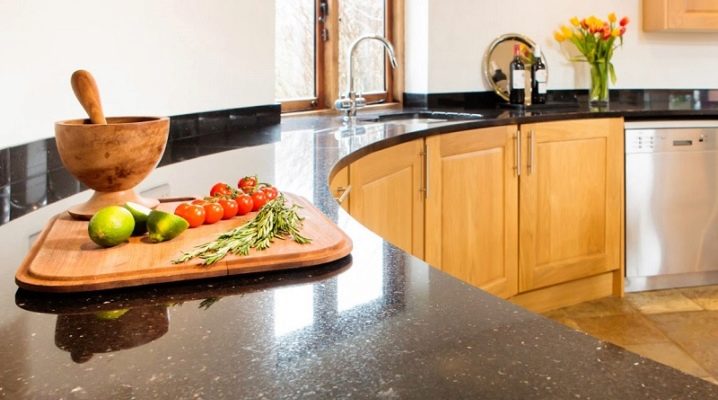
The kitchen set must be ergonomic. Despite the simplicity of the procedures for cooking and cleaning the dishes, its characteristics - height, width and depth - are of great importance for the convenience of using furniture. For this, a system of standards was developed. It is worth considering in more detail what it is and how to use it.

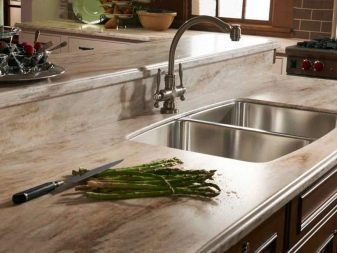
How does the height of a kitchen countertop depend on height?
Ergonomics deals with the study of human movement in specific conditions and rooms, as well as the organization of space. Therefore, to make it more convenient for housewives to use the kitchen, a standard was developed for the distances from one working area to another, the width and depth of the working surface, and the height of the object used. In the kitchen, work is done while standing, so you should consider the correct height for headsets for people of different heights in order to reduce the stress on the joints and spine during the cooking process. The standard size of kitchen furniture was developed in the 50s of the last century. Indicators of the height of the placement of drawers and countertops depend on the height of the woman. The average height of women was 165 cm, according to the norms, the height of the table from the floor with this height should be 88 cm.
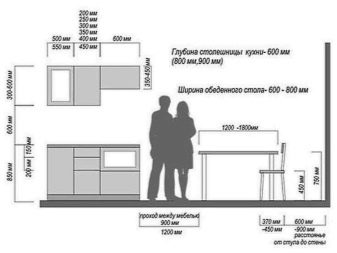
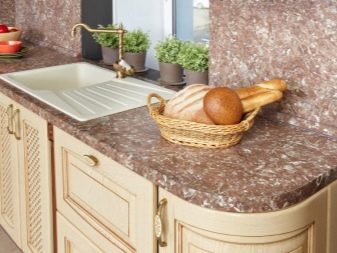
For the individual selection of the height of the tabletop, they are guided by the following parameters:
- height and area of the countertop;
- illumination of the working area.
It is worth familiarizing yourself with the following table, which shows the values \ u200b \ u200bof the tabletop heights for people of different heights:
Height | Distance from the floor |
up to 150 cm | 76-82 cm |
from 160 to 180 cm | 88-91 cm |
above 180 cm | 100 cm |
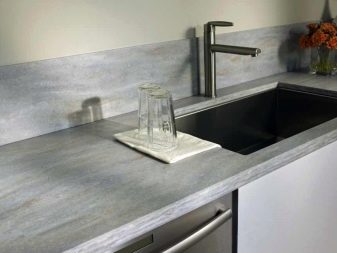
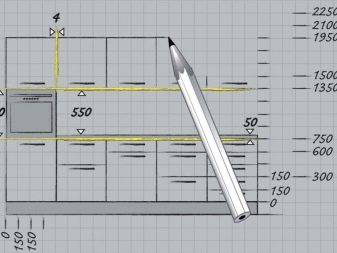
Standard sizes
Standardized sizes of kitchen items reduce the cost of materials from which it is made, give a wide choice to buyers. Furniture can be purchased from different suppliers without having to think about the fact that some items may not fit in a given space due to their different characteristics.
It is worth paying attention to several norms for countertops.
- Tabletop thickness ranges from 4 to 6 cm - these figures must be taken into account to determine the total height of the kitchen unit, including the height of the legs, which is usually 10 cm.The thickness of less than 4 cm is almost never encountered, as well as more than 6 cm. These indicators are due to the ability of the countertop to withstand heavy objects and the optimization of the height of the entire kitchen unit ...
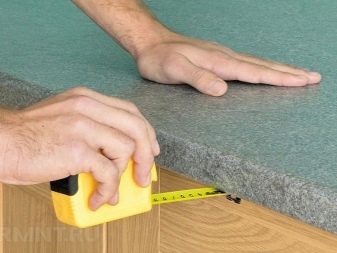
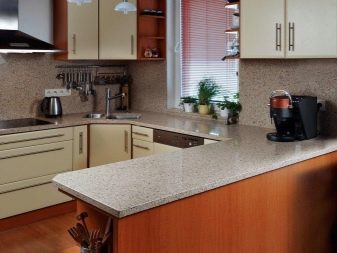
- The standard for the width of the table top made by manufacturers is 60 cm. For self-production and for individual orders, it is permissible to increase the width by 10 cm. It is not recommended to reduce the width, narrow tabletops are inconvenient to use in the presence of wall cabinets, the head will be located close to the front of the cabinet. And also a width of less than 60 cm does not allow a comfortable position of a person behind the working surface due to the impossibility of normal setting of the legs and the body near the facades of the lower drawers and the plinth.
- The length of the countertop is determined by the space it takes. Of the standard values, 60 cm is allocated to the zone for the sink and hob, and the working surface on average takes 90 cm.At the same time, according to safety standards, there should be a free space within 10 cm between the refrigerator and the sink or stove. at least 220 cm.The length of the cutting zone can be shortened, but this will inconvenience the preparatory cooking process.


Possible variations
Compared to a standard flat surface, there is a variant of distributed zones, each of which is different in its height. Such a tabletop is considered multi-level and is designed for the following tasks:
- maximum facilitation of the process of using the kitchen;
- reducing the load on the back of a person;
- division of space into zones when it is impossible to install a standard tabletop.
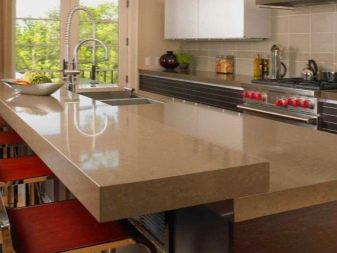
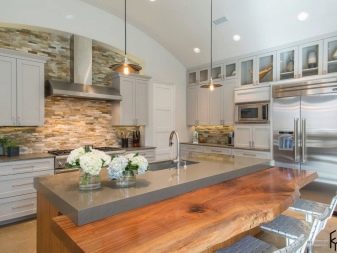
The countertop area is occupied by a sink, a work surface and a stove. It is recommended to install the sink 10-15 cm higher than the working surface set aside for cooking and cutting food. It is desirable that the sink protrudes slightly forward relative to the plane of the countertop or is located on its front edge, due to this placement, the hostess will not have an instinctive desire to lean forward while washing the dishes.
If it is not possible to raise the level of the countertop, then overhead sinks are used. They are installed on a finished surface, on which a hole is cut for water drainage.
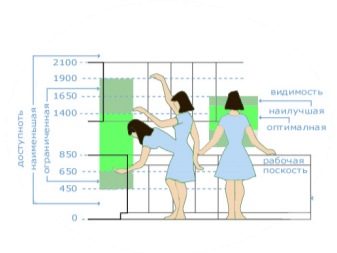
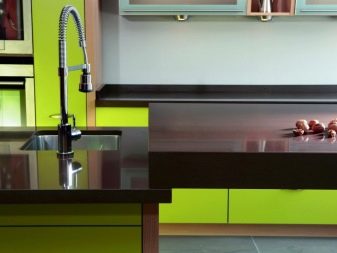
The hob in the multilevel area is located below the cutting area. This arrangement provides the convenience of using hot kitchen items and, due to the low height of the countertop, move the oven to the level of the human body or on top of the countertop. The high position of the oven reduces the risk of injury and burns from pulling hot food out of the oven. The cutting area remains unchanged and is equal to the standard worktop heights.
Important! Of the minuses of a multi-level countertop, it is worth noting the possibility of injury due to grazing objects at different levels. To reduce the risk of emergencies, it is advisable to separate each zone with bumpers along the perimeter and sides of the table top.
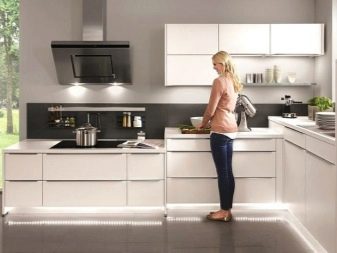
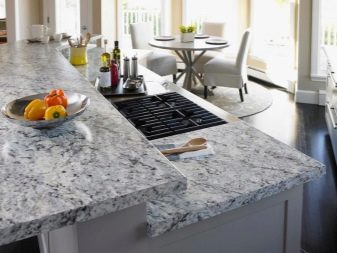
The best option is to divide the zones into a separate work area, as well as a sink and a hob, separated by free space. This arrangement is called an island. The working area in height is equal to the standard value, depending on the height of the person. And it is also possible to customize an additional tabletop on top of the worktop, which serves as a bar counter or a dining table. In this case, the thickness of the material is chosen within 6 cm, high legs or hollow cabinets serve as support.
Another option is to combine the wall with the countertop. This design technique allows you to free up space under the worktop and position the worktop at any height. And also this method has a decorative function and is applicable in small spaces, but requires accurate calculations of the load on the countertop. In shape, the tabletop resembles an inverted letter G. The longest part is attached to the wall, the free zone remains intact, floating freely or is fixed to the floor using a metal or wooden holder, sidewall.
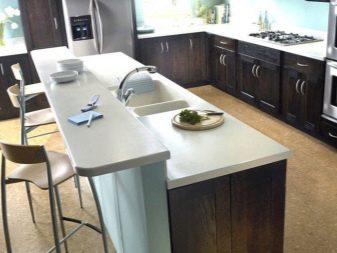

In terms of shape, the edges of the table top are even straight, with rounded corners or gently sloping asymmetric. They are of the same value or different in depth. Each value corresponds to a specific zone. For example, this method is used in U-shaped kitchens, where the zones of the sink and hob protrude 20-30 cm forward compared to the cutting surface.
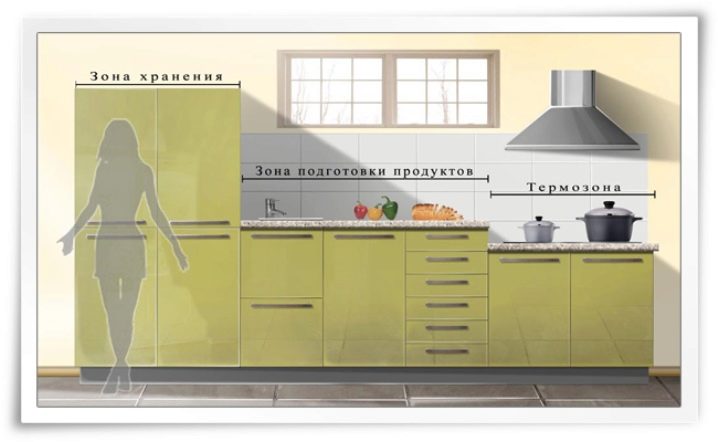
How to calculate?
Calculations for kitchen furniture include the following values:
- the width of the opening where the boxes will be installed,
- bottom headset height;
- level of wall cabinets and hoods;
- distance between worktop and top drawers.
Important! Each indicator has standard values, but individual measurements may be required.
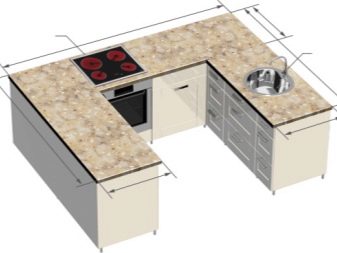
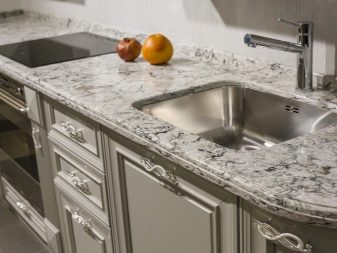
An approximate calculation of the lower kitchen set for a hostess with a height of 170 cm: 89 cm (standard height according to the table) - 4 cm (countertop thickness) - 10 cm (leg height) = 75 cm is the height of the kitchen cabinets.This indicator should be taken into account when purchasing kitchen furniture from different suppliers or when assembling it yourself, so as not to exceed the countertop heights, which will lead to inconvenience in using the work surface. The distance between the worktop and the hanging drawers ranges from 45 to 60 cm. This distance is optimal for being able to fully see the work surface and for easy removal of accessories from the hanging drawers. The distance to the hood is 70 cm or more if it is stationary or not fitted into the cabinet body.

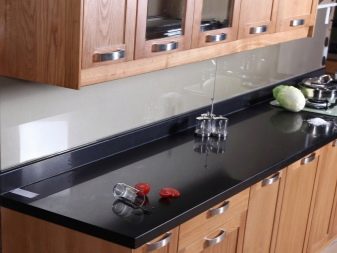
All measurements are made with a tape measure or laser measuring tape. If there is no tool, then the calculations can be done with your hand. To do this, you should stand up straight, the arm is bent at the elbow, forming an angle of 90 degrees. The forearm is in a horizontal plane, the shoulder is in an upright position. In this position, you must open your palm towards the floor, straight down. The distance from the floor to the palm is equal to the height of the lower kitchen unit together with the tabletop and legs.
Incorrect calculations will lead to such consequences as:
- inconvenience of using the work surface and cabinets;
- the impossibility of a convenient location behind the countertop;
- the impossibility of installing a kitchen set on a level.
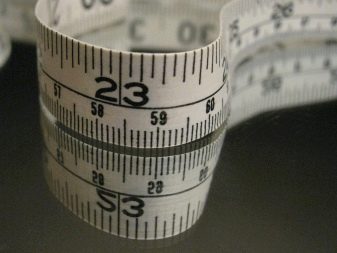

How to increase it yourself?
If the level of the countertop height is small, you can independently bring it to the required values.
- Adjustable feet. Many ready-made kitchen modules are equipped with adjustable legs, with the help of which you can increase the height of the kitchen unit by 3-5 cm or install new holders yourself. Some firms produce products that differ from standard sizes. The main thing is that the diameter of the legs is at least 4 cm. Wide legs provide a more even distribution of the weight of the entire structure and affect its stability.

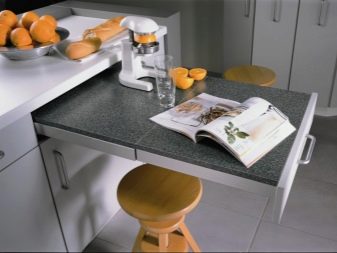
- Change the standard thickness of the table top. Today, there are surfaces on the market with a thickness of up to 15 cm, but such materials will not allow you to screw a meat grinder to them in the kitchen. Of the advantages, it is worth noting that monumental surfaces are more resistant to damage and durable in use, and it is also easier to install built-in appliances into such surfaces.
- Place the kitchen unit on a pedestal. This method is used when it is not possible to increase the height of the finished kitchen set for a tall person or visual zoning of the space.
- Separation of the countertop from the kitchen set by means of "legs" or side holders. This method is only suitable for completely closed drawers, leaving free space between the drawer and the worktop.
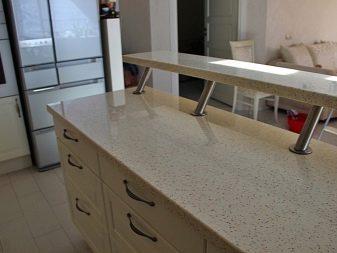

Design Tips
It is worth adhering to the following recommendations from professionals.
- for small rooms reserved for the kitchen, it is worth using the divided zones method; the working area is located separately from the sink and the hob, it can serve as a dining table;
- if there is a window in the kitchen, then it is combined with the working area with a solid tabletop, which adds additional meters of the working area;
- in large kitchens, an island or a single shape resembling the letter P is used;
- the distance between parallel zones reaches up to 1.5 meters for convenient and fast movement.
- the process of installing the countertop does not require special skills;
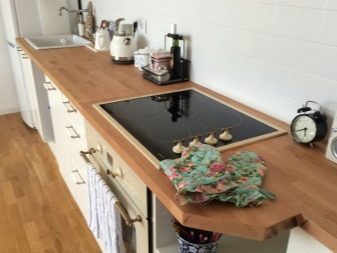

- the finished surface is installed on kitchen drawers and fixed with self-tapping screws or corners;
- on each kitchen set in the upper part of the case, transverse bars are installed, it is they who serve as the basis for connecting the countertop and the drawer;
- an unfixed tabletop, despite the fact that it has sufficient weight, can slide off the surface on which it is located if the headsets are different in height or are on an uneven floor;
- the sink and hob are mounted after fixing the countertop - the future arrangement of objects is marked on the surface, the holes are cut with a grinder;
- the junction of two tabletops is closed with a metal or wooden frame; the gaps between the countertop and the wall are decorated with a kitchen corner, and for additional protection from moisture and dirt, the gaps are coated with sealant;


- if the edge of the tabletop made of MDF or chipboard is not processed, then decorative adhesive tape or paste should be used to protect the material from the effects of water, because this material is more susceptible to deformation than others - delamination, mold formation.
For information on which countertop is better to choose, see the next video.













The comment was sent successfully.